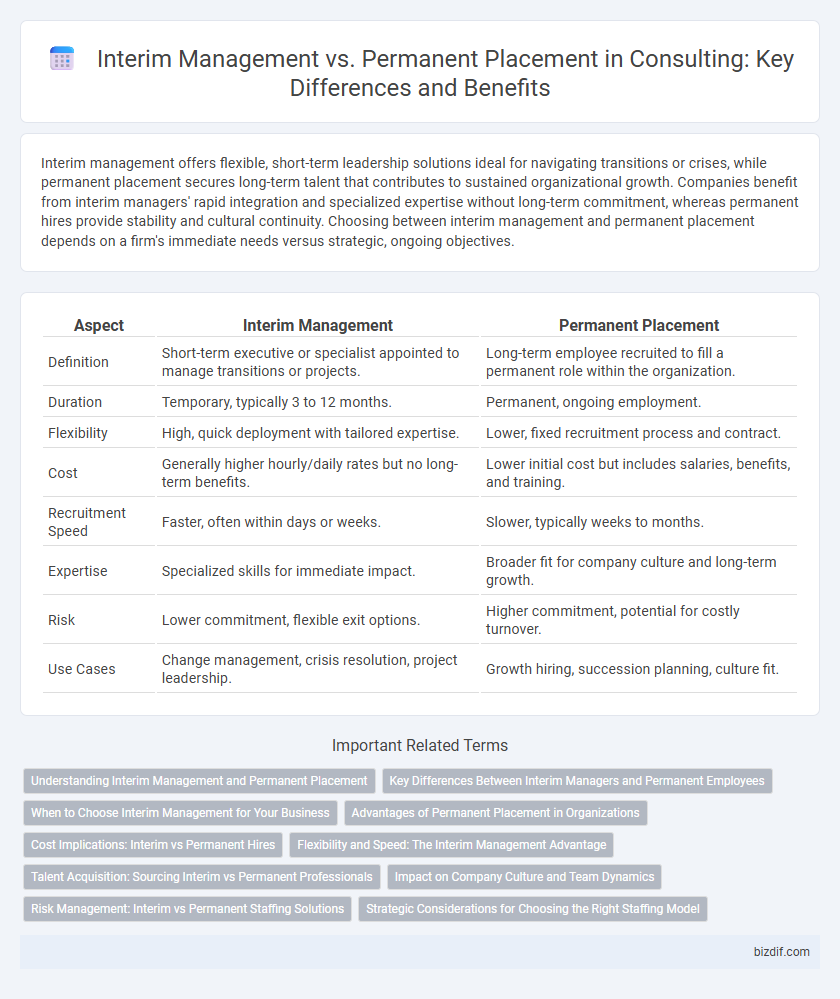Interim management offers flexible, short-term leadership solutions ideal for navigating transitions or crises, while permanent placement secures long-term talent that contributes to sustained organizational growth. Companies benefit from interim managers' rapid integration and specialized expertise without long-term commitment, whereas permanent hires provide stability and cultural continuity. Choosing between interim management and permanent placement depends on a firm's immediate needs versus strategic, ongoing objectives.
Table of Comparison
| Aspect | Interim Management | Permanent Placement |
|---|---|---|
| Definition | Short-term executive or specialist appointed to manage transitions or projects. | Long-term employee recruited to fill a permanent role within the organization. |
| Duration | Temporary, typically 3 to 12 months. | Permanent, ongoing employment. |
| Flexibility | High, quick deployment with tailored expertise. | Lower, fixed recruitment process and contract. |
| Cost | Generally higher hourly/daily rates but no long-term benefits. | Lower initial cost but includes salaries, benefits, and training. |
| Recruitment Speed | Faster, often within days or weeks. | Slower, typically weeks to months. |
| Expertise | Specialized skills for immediate impact. | Broader fit for company culture and long-term growth. |
| Risk | Lower commitment, flexible exit options. | Higher commitment, potential for costly turnover. |
| Use Cases | Change management, crisis resolution, project leadership. | Growth hiring, succession planning, culture fit. |
Understanding Interim Management and Permanent Placement
Interim Management involves hiring experienced professionals for short-term, project-based roles to address specific organizational needs or crises, providing flexibility and rapid deployment. Permanent Placement refers to the recruitment of candidates for long-term roles, aimed at building sustainable leadership and ensuring continuity within the company. Both strategies differ in commitment duration, cost structure, and talent integration, impacting organizational agility and succession planning.
Key Differences Between Interim Managers and Permanent Employees
Interim managers bring specialized expertise for short-term, project-based roles, offering flexibility and rapid deployment without long-term commitments. Permanent employees provide continuity, culture integration, and sustained team development, contributing to long-term organizational growth. Key differences include contract duration, cost structure, decision-making authority, and adaptability to changing business needs.
When to Choose Interim Management for Your Business
Interim management is ideal for businesses facing short-term challenges, such as organizational transformation, crisis response, or project-specific expertise requiring immediate impact without long-term commitment. Companies experiencing rapid change or needing specialized skills temporarily benefit from the flexibility and speed of interim managers compared to permanent placements. Choosing interim management helps maintain operational continuity while allowing time to identify the right permanent candidate or adjust strategic directions.
Advantages of Permanent Placement in Organizations
Permanent placement provides organizations with long-term stability and sustained expertise, aligning talent with company culture and strategic goals. Employees in permanent roles typically show higher commitment and motivation, reducing turnover and fostering team cohesion. Investing in permanent placements enhances knowledge retention and drives consistent performance improvements across departments.
Cost Implications: Interim vs Permanent Hires
Interim management incurs higher hourly rates but offers cost savings through flexible, short-term engagement without long-term benefits or severance expenses. Permanent placements involve ongoing salaries, benefits, recruitment costs, and potential redundancy liabilities, increasing total cost of ownership. Companies weigh interim cost efficiency for project-based needs against permanent hires' value for sustained organizational growth.
Flexibility and Speed: The Interim Management Advantage
Interim Management offers unmatched flexibility and rapid deployment compared to Permanent Placement, enabling companies to swiftly address critical leadership gaps without long-term commitments. Organizations benefit from experienced professionals who can seamlessly integrate into projects and drive immediate results during periods of transition or transformation. This agility allows businesses to adapt to market changes quickly while controlling costs associated with recruitment and onboarding.
Talent Acquisition: Sourcing Interim vs Permanent Professionals
Talent acquisition strategies differ significantly between interim management and permanent placement, with sourcing interim professionals emphasizing agility, specialized skills, and rapid deployment to address immediate business challenges. Permanent placement requires a deeper focus on cultural fit, long-term potential, and comprehensive assessment to ensure sustained organizational growth. Leveraging targeted talent pools and advanced sourcing technologies enhances the precision and efficiency of acquiring both interim and permanent professionals.
Impact on Company Culture and Team Dynamics
Interim Management introduces experienced leaders to rapidly address specific challenges, fostering adaptability without long-term cultural shifts. Permanent Placement embeds professionals who influence company culture and team dynamics over time, driving sustained alignment and cohesion. Choosing between interim and permanent solutions depends on the company's need for immediate impact versus enduring cultural integration.
Risk Management: Interim vs Permanent Staffing Solutions
Interim management offers flexible risk mitigation by allowing organizations to quickly adapt leadership during uncertainty or transitions without long-term commitment costs. Permanent placement involves higher risk exposure due to fixed contracts and prolonged financial obligations, but provides stability and deep organizational integration. Effective risk management requires evaluating the urgency of leadership needs and the potential impact on operational continuity.
Strategic Considerations for Choosing the Right Staffing Model
Interim management offers flexibility and rapid deployment for urgent or transitional strategic needs, making it ideal for companies facing market disruption or organizational change. Permanent placement ensures long-term alignment with corporate culture and sustained strategic influence, crucial for stability and continuous growth. Evaluating project duration, budget constraints, and required expertise guides organizations in selecting the most effective staffing model to meet specific business objectives.
Interim Management vs Permanent Placement Infographic

 bizdif.com
bizdif.com